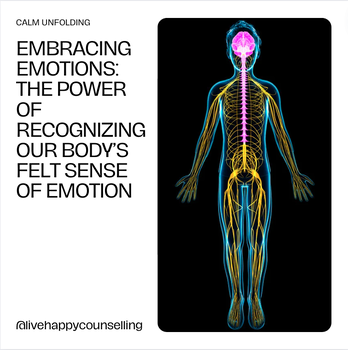|
In the journey of emotional healing, understanding the felt sense of emotion is a cornerstone. Somatic awareness refers to the conscious perception and attention to bodily sensations. These sensations are the embodiment of emotion because emotions are not solely mental states; they are also deeply intertwined with physical experiences in the body. Somatic awareness plays a key role in understanding and processing emotions. Somatic awareness is an integral part of trauma treatment and is central to EMDR therapy. The Mind and Body of Emotion Emotions are not just abstract concepts; they have physical manifestations. For example, anger might manifest as muscle tension or shallow breathing; fear might lead to an increased heart rate, sweating, or a sensation of tightness in the chest; and happiness might manifest as a sense of lightness or warmth. We can gain deeper insight into our emotional state by becoming aware of these physical cues. This awareness is more than just an intellectual exercise; it's a path to deeper emotional understanding, self-awareness, and healing. Tracking the Felt Sense of Emotion Learning to track the felt sense of emotion is a critical skill in emotional regulation, involving a keen awareness and understanding of one's bodily sensations that accompany emotions. And, becoming attuned to the subtle changes within the body that signal emotional shifts is a core feature of EMDR. A Gentle Approach to Somatic Experiencing Here's a simple guide to start noticing your body's emotional signals:
Overcoming Discomfort If this process feels uncomfortable, remember it's a natural part of emotional growth. Start with momentary noticing and gradually increase the duration as you become more comfortable with the practice. It’s important to be patient and kind to yourself through this process. Working with a Counsellor - Don't Go It Alone! While these techniques can be practiced independently, working with a Counsellor can be incredibly beneficial. A Counsellor can provide guidance, support, and personalized strategies to help you navigate and understand your emotional landscape more effectively. Waking Up the Nervous System For those who have a habit of suppressing or avoiding emotions, gently stimulating the nervous system can be beneficial. This helps to 'wake up' the nervous system from shutdown. Here are some methods:
Remember, you know yourself best. Listen to your body, and use what feels right for you.
The Journey Toward Emotional Awareness Learning to regulate emotions isn't an innate skill; it's something we acquire over time, often through guidance and practice. Without such learning opportunities, becoming aware of our emotional sensations can seem overwhelming. Initially, if we haven't been taught to recognize and sit with our emotions without feeling overpowered by them, our instinct might be to push these feelings away, ignore them, or seek distraction. Over time, these avoidance strategies can become deeply ingrained, making the idea of facing intense emotions intimidating. Feeling uncertain, uncomfortable, or even overwhelmed when starting to notice and describe emotional sensations in your body is entirely expected. It's akin to the early stages of learning any new skill, where everything feels unfamiliar and challenging. The key is to recognize and stay present with these emotional sensations despite the discomfort. In light of this, EMDR therapists introduce emotional and somatic awareness gradually. It's a process that respects your pace, gently encouraging the exploration of the felt sense of emotion and learning to observe their rise and fall. This gentle approach aims to build your comfort with naming and noticing these sensations, thereby enhancing your ability to remain grounded in the present moment. Through this supportive framework, you'll gradually develop a more profound capacity to engage with emotions, transforming what might once have seemed daunting into a source of strength and insight.
0 Comments
Your comment will be posted after it is approved.
Leave a Reply. |
AuthorSusan Guttridge is a trauma-informed Master level Counsellor with the clinical designation of Canadian Certified Counsellor (CCPA). She has 20+ years experience providing individual and group therapy. Archives
January 2024
Categories
All
|


 RSS Feed
RSS Feed